Characterised by heterotrophic eukaryotic, multicellular and their cells lack cell walls.
Digest their food in an internal cavity and store food reserves as glycogen or fat.
Mode of nutrition is holozoic – by ingestion of food. Definite growth pattern and grow into adults that have a definite shape and size
BASIS OF CLASSIFICATION
Fundamental features common to various individuals in relation to the arrangement of cells, body symmetry, nature of coelom, patterns of digestive, circulatory or reproductive systems. These features are used as the basis of animal classification.
Levels of Organization
Cellular level
In sponges(Porifera) the cells are arranged as loose cell aggregates, activities occur among the cells.
Tissue level
In coelenterates, the arrangement of cells is more complex cells performing the same function are arranged into tissues.
Organ level
In Platyhelminthes and other higher phyla where tissues are grouped together to form organs, each specialised for a particular function.
Organ System level
In animals like Annelids, Arthropods, Molluscs, Echinoderms and Chordates, organs have associated to form functional systems, each system concerned with a specific physiological function.
The digestive system
Incomplete Digestive system
Platyhelminthes has only a single opening to the outside of the body that serves as both mouth and anus, and is hence called incomplete. (NEET 2010)
Complete digestive system
It has two openings, mouth and anus
Circulatory System
Open type
in which the blood is pumped out of the heart and the cells and tissues are directly bathed in it.
Closed type
in which the blood is circulated through a series of vessels of varying diameters (arteries, veins and capillaries).
Symmetry:-
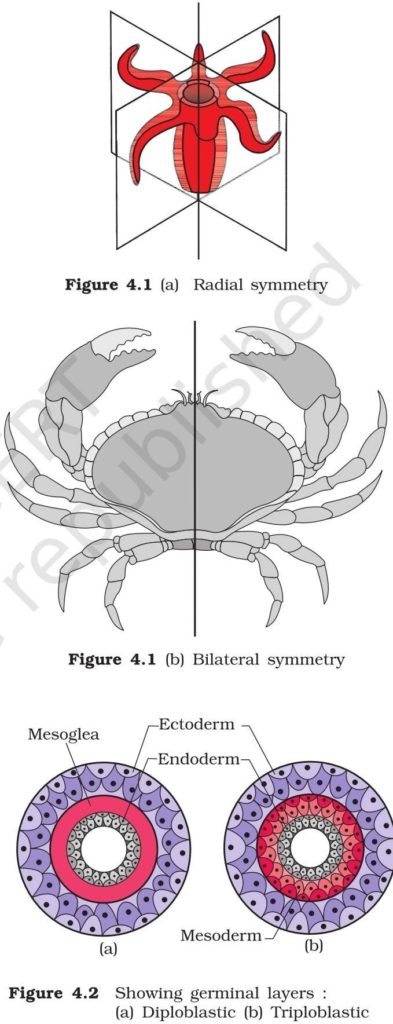
(i) Asymmetrical
Any plane that passes through the centre does not divide them into equal halves.
(ii) Radial
any plane passing through the central axis of the body divides the organism into two identical halves.
Example- Coelenterates, ctenophores and echinoderms .
(iii) Bilateral
The body can be divided into identical left and right halves in only one plane.
Example- Animals like annelids, arthropods, etc
Diploblastic and Triploblastic Organisation
(I) Diploblastic
Animals in which the cells are arranged in two embryonic layers, an external ectoderm and an internal endoderm. Example - coelenterates. An undifferentiated layer, mesoglea, is present in between the ectoderm and the endoderm
An undifferentiated layer, mesoglea, is present in between the ectoderm and the endoderm
(ii) Triploblastic
Animals in which the developing embryo has a third germinal layer, mesoderm, in between the ectoderm and endoderm.
Example- Platyhelminthes to chordates.
Coelom
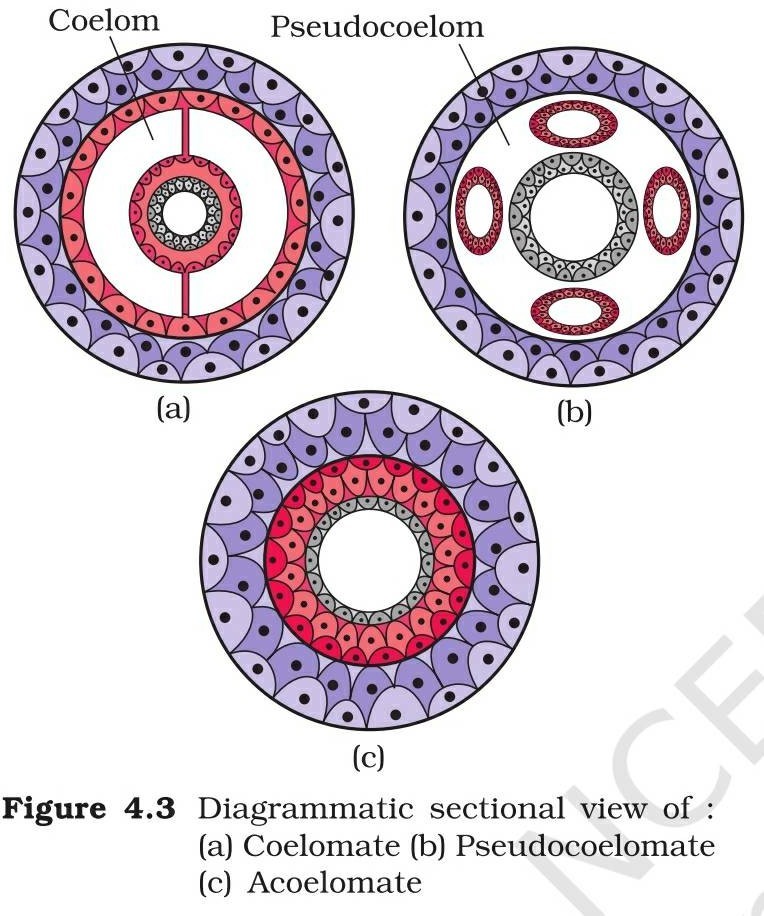
Presence or absence of a cavity between the body wall and the gut wall is very important in classification.
Coelomates -
The body cavity, which is lined by mesoderm is called coelom.
Example- annelids, molluscs, arthropods, echinoderms, hemichordates and chordates
Pseudocoelomates
In some animals, the body cavity is not lined by mesoderm, instead, the mesoderm is present as scattered pouches in between the ectoderm and endoderm. Example- Aschelminthes
Acoelomates
The animals in which the body cavity is absent. Example- Platyhelminthes
Segmentation
- The body is externally and internally divided into segments with a serial repetition of at least some organs.
- For example, in earthworm, the body shows this pattern called metameric segmentation and the phenomenon is known as metamerism.
Notochord
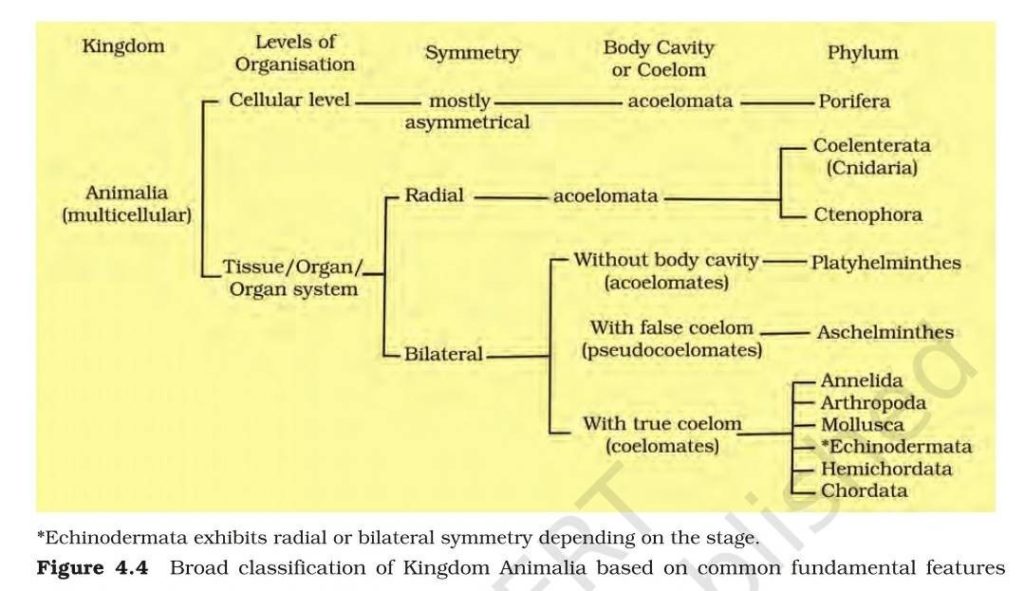
Notochord is a mesodermally derived rod-like structure formed on the dorsal side during embryonic development in some animals. Animals with notochord are called chordates and those animals which do not form this structure are called non-chordates, e.g., porifera to echinoderms.
Classification of Animals
Based on common fundamental features given in Fig 4.4
Phylum - Porifera
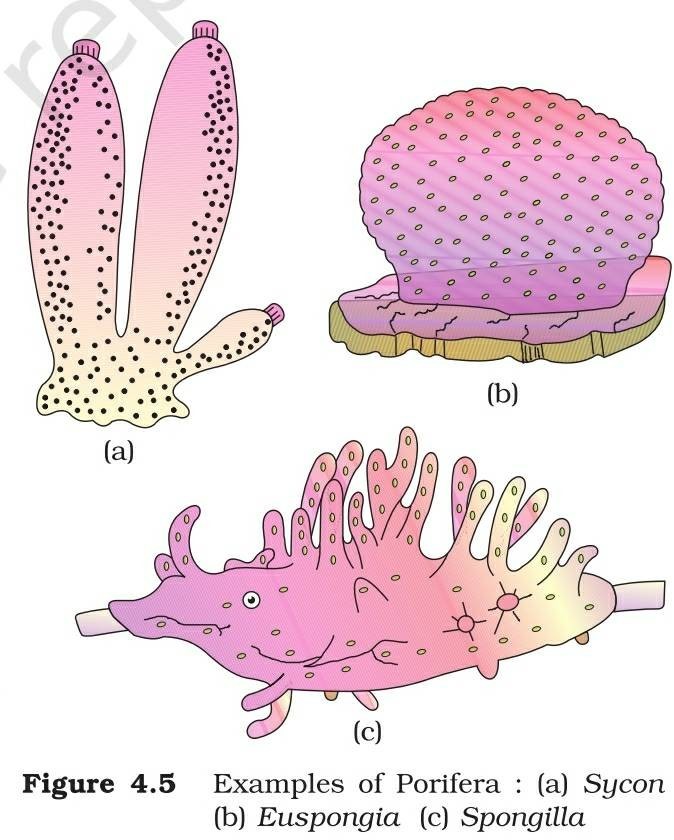
- Commonly known as sponges.
- Generally marine and mostly asymmetrical animals.
- Multicellular animals and have cellular level of organisation. (NEET 2011)
- A water transport or canal system helpful in food gathering, respiratory exchange and removal of waste.
- Water enters through minute pores (ostia) in the body wall into a central cavity, spongocoel, from where it goes out through the osculum.
Choanocytes or collar cells line the spongocoel and the canals. (NEET 2017)
- Digestion is intracellular.
- Body is supported by a skeleton made up of spicules or spongin fibres.
- Sexes are not separate (hermaphrodite), i.e., eggs and sperms are produced by the same individual.
•Reproduction -
- Asexually by fragmentation
- Sexually by formation of gametes.
- Fertilisation is internal and development is indirect having a larval stage which is morphologically distinct from the adult.
- Example - Sycon (Scypha), (NEET 2012) Spongilla (Fresh water sponge) and Euspongia (Bath sponge).
Phylum – Coelenterata (Cnidaria)
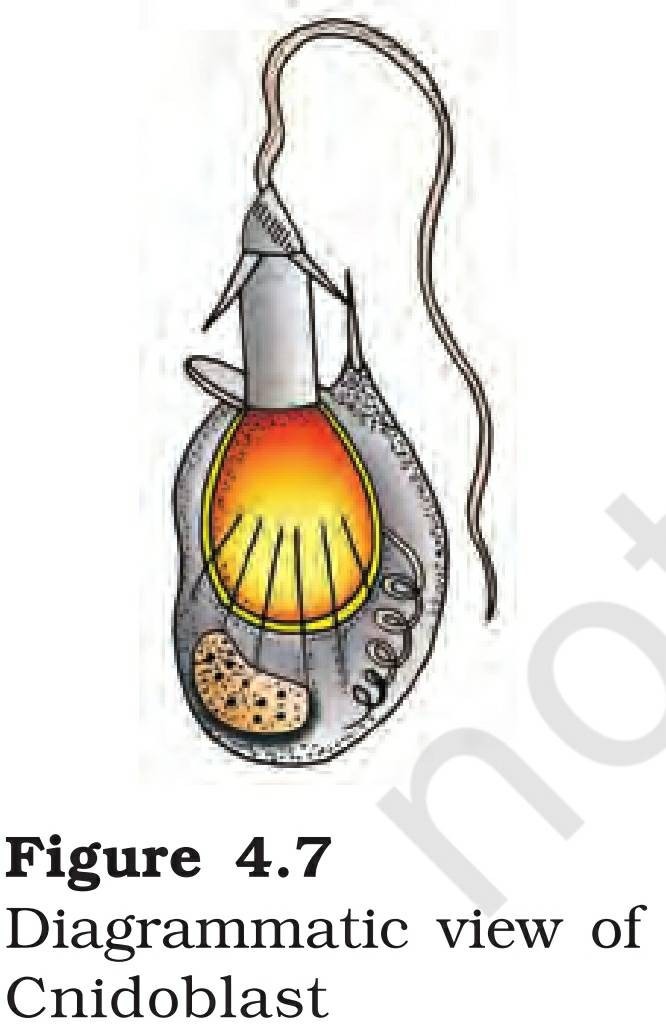
- Aquatic, mostly marine but some are fresh water also. (NEET 2014)
- sessile or free-swimming, radially symmetrical animals.
- Cnidaria name derived from cnidoblasts or cnidocytes (which contain the stinging capsules or nematocysts) present on the tentacles and the body. (NEET 2011)
- Used for anchorage, defense and for the capture of prey.
- Tissue level of organisation and are diploblastic.
- Central gastro-vascular cavity with a single opening, mouth on hypostome.
- Digestion is extracellular and intracellular.
- Some of the cnidarians, e.g., corals have a skeleton composed of calcium carbonate.
- Cnidarians exhibit two basic body forms
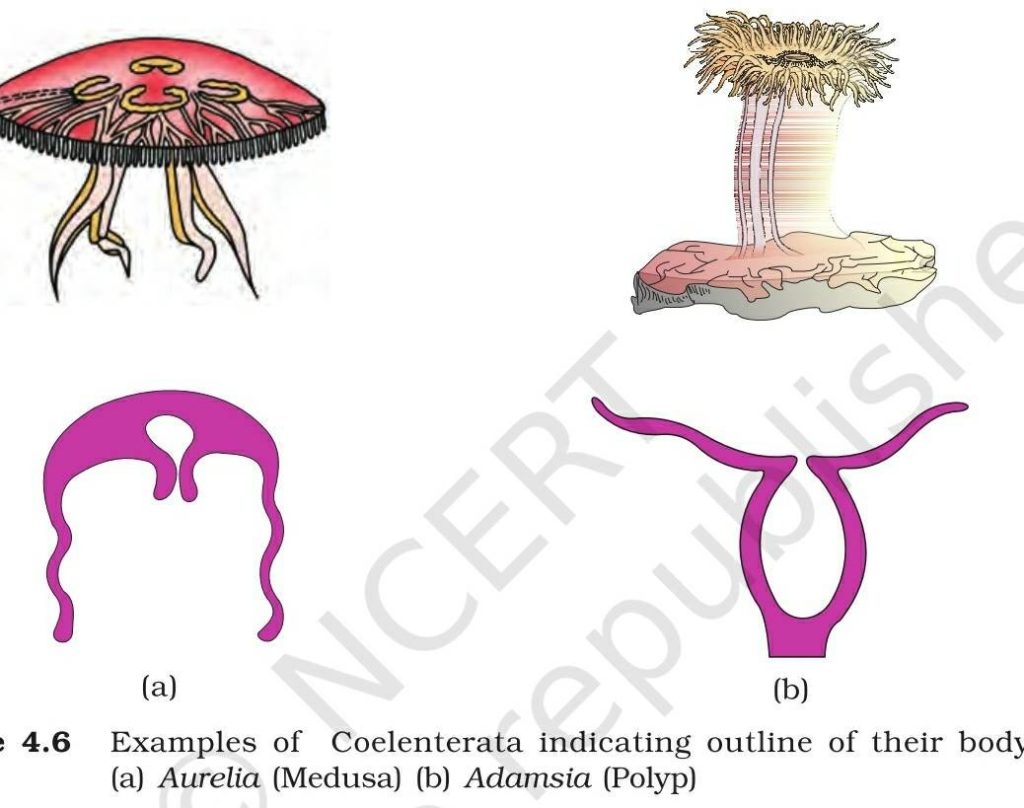
- Polyp - sessile and cylindrical form like Hydra, Adamsia, etc.
- Medusa - umbrella-shaped and free-swimming like Aurelia or jelly fish. (NEET 2011)
- Exhibit alternation of generation (Metagenesis), i.e., polyps produce medusae asexually and medusae form the polyps sexually (e.g., Obelia). (NEET 2015) Examples: Physalia (Portuguese man-of-war), Adamsia (Sea anemone), (NEET 2013) Pennatula (Sea-pen), Gorgonia (Sea-fan) (NEET 2014) and Meandrina (Brain coral).
Phylum - Ctenophora
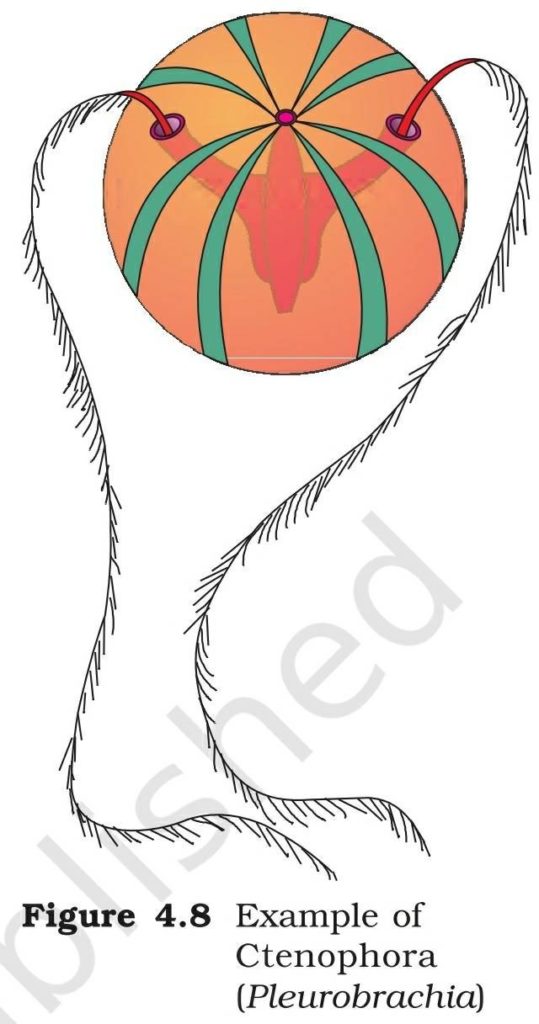
- Commonly known as sea walnuts or comb jellies are exclusively marine. (NEET 2014)
- radially symmetrical, diploblastic organisms with tissue level of organisation.
- Body bears eight external rows of ciliated comb plates, which help in locomotion. (NEET 2019)
- Digestion is both extracellular and intracellular.
Bioluminescence
(the property of a living organism to emit light) is well-marked in ctenophores.
- Sexes are not separate.
- Reproduction takes place only by sexual means.
- Fertilisation is external with indirect development. Examples: Pleurobrachia and Ctenoplana.
Phylum – Platyhelminthes
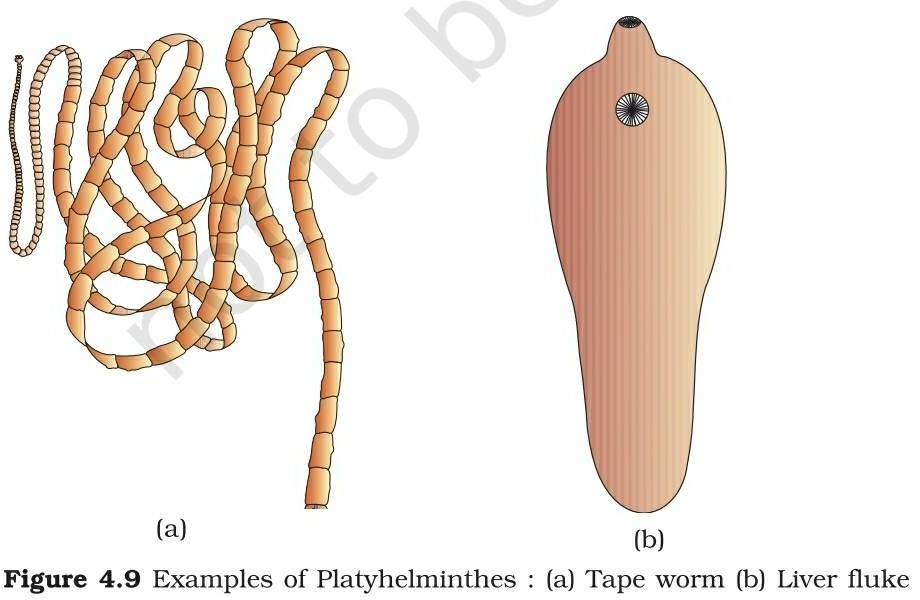
- Dorso-ventrally flattened body (flatworms)
- Mostly endoparasites found in animals including human beings.
- Bilaterally symmetrical, triploblastic and acoelomate animals with organ level of organisation.
- Hooks and suckers are present in the parasitic forms. Some of them absorb nutrients from the host directly through their body surface.
- Specialised cells called flame cells help in osmoregulation and excretion. (NEET 2019)
- Sexes are not separate. Fertilisation is internal and development is through many larval stages.
- Some members like Planaria possess high regeneration capacity. (NEET 2014)
- Examples: Taenia (Tapeworm) (NEET 2019) Fasciola (Liver fluke) (NEET 2010)
Phylum - Aschelminthes
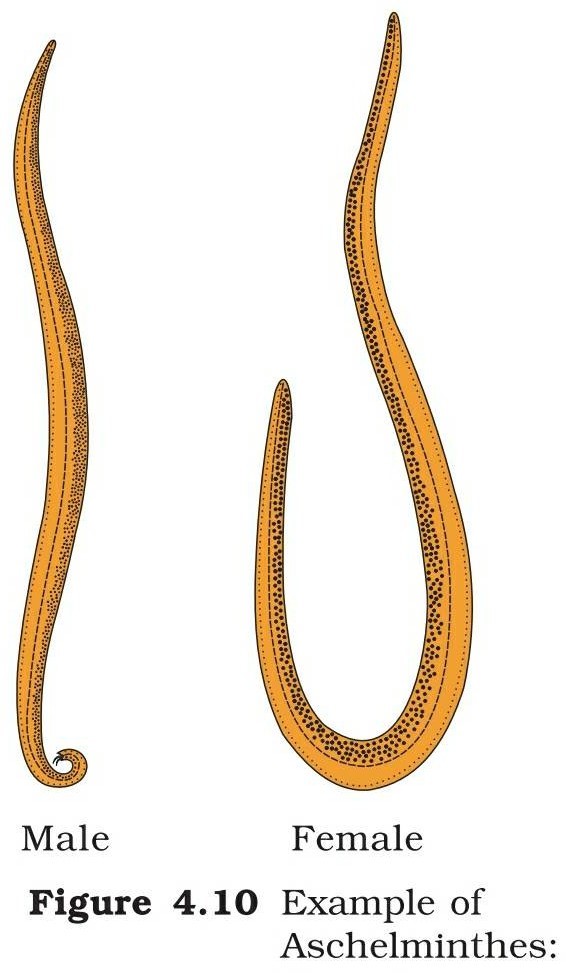
- Circular in cross-section (roundworms)
- May be free living, aquatic and terrestrial or parasitic in plants and animals.
- organ-system level of body organisation, bilaterally symmetrical, triploblastic and pseudocoelomate animals.
- Alimentary canal is complete with a well developed muscular pharynx.
- An excretory tube removes body wastes from the body cavity through the excretory pore.
- Sexes are separate (dioecious), i.e., males and females are distinct.
- Females are longer than males.
- Fertilisation is internal and development may be direct (the young ones resemble the adult) or indirect.
- Examples : Ascaris (Roundworm) (NEET 2011) ,Wuchereria (Filaria worm), Ancylostoma (Hookworm).
Phylum – Annelida
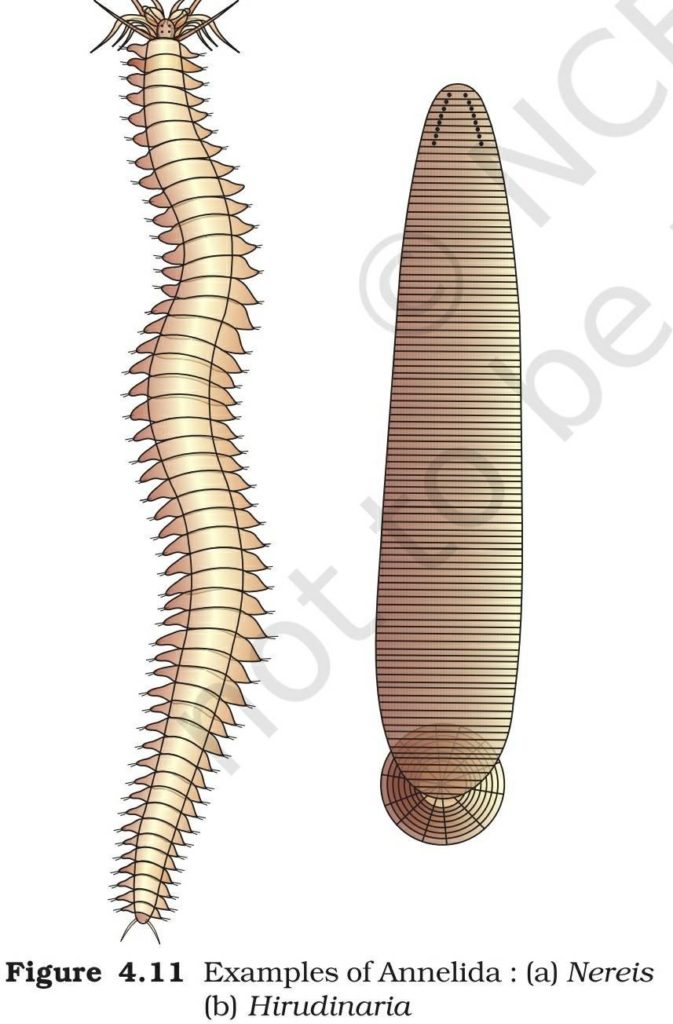
- May be aquatic (marine and fresh water) or terrestrial; free-living, and sometimes parasitic.
- Organ-system level of body organisation, bilateral symmetry, triploblastic, metamerically segmented and coelomate animals.
- Body surface is distinctly marked out into segments or metameres and, hence, the phylum name Annelida (Latin, annulus : little ring)
- Longitudinal and circular muscles which help in locomotion.
- Aquatic annelids like Nereis possess lateral appendages, parapodia, which help in swimming. (NEET 2016)
- A closed circulatory system is present.
- Nephridia (sing. nephridium) help in osmoregulation and excretion.
- Neural system consists of paired ganglia (sing. ganglion) connected by lateral nerves to a double ventral nerve cord.
- Nereis, an aquatic form, is dioecious, but earthworms and leeches are monoecious.
- Reproduction is sexual.
- Earthworm does not undergo metamorphosis because development is direct and no larva stage is present. (NEET 2018)
- Example - Nereis, Pheretima (Earthworm) and Hirudinaria (Blood sucking leech).
Phylum - Arthropoda
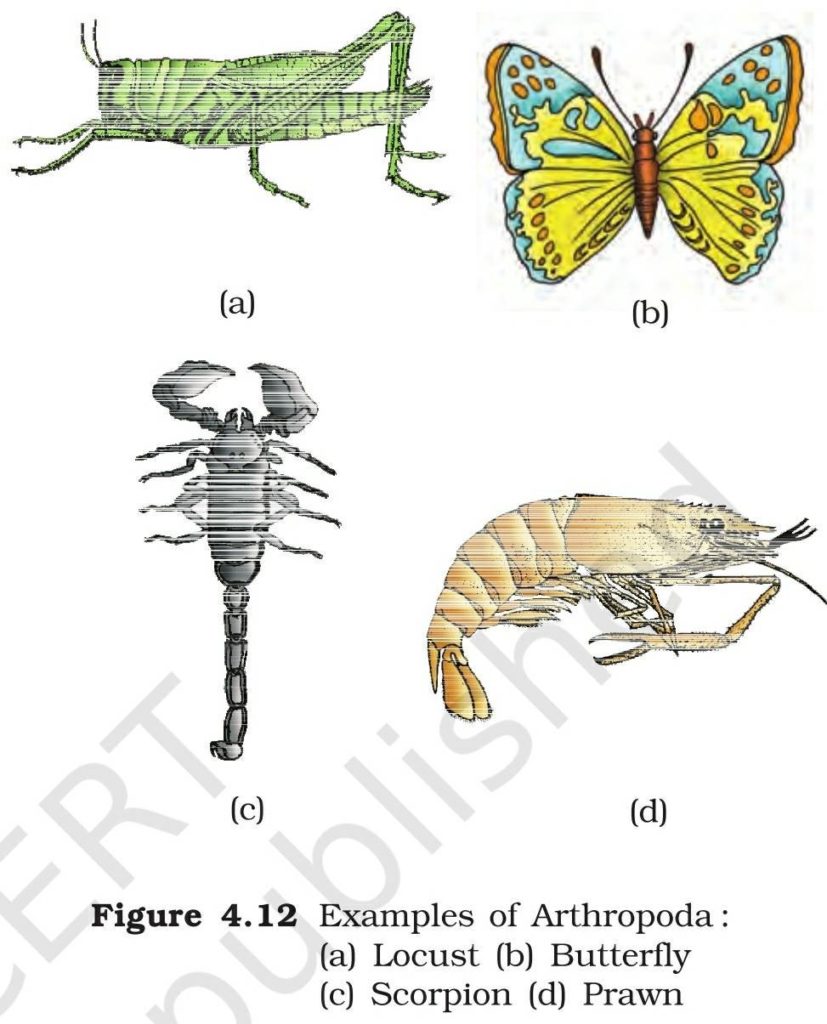
- Largest phylum of Animalia which includes insects. Over two-thirds of all named species on earth are arthropods. (NEET 2011)
- Organ-system level of organisation, bilaterally symmetrical, triploblastic, segmented and coelomate animals.
- The body of arthropods is covered by chitinous exoskeleton.
- Body consists of head, thorax and abdomen.
- Jointed appendages (arthros-joint, poda-appendages). (NEET 2012,2016)
- Respiratory organs are gills, book gills, book lungs or tracheal system.
- Circulatory system is of open type.
- Sensory organs like antennae, eyes (compound and simple), statocysts or balancing organs are present.
- Excretion takes place through malpighian tubules. (NEET 2019)
- Mostly dioecious.
- Fertilisation is usually internal (mostly oviparous).
- Development may be direct or indirect. Examples:
Economically important insects – Apis (Honey bee), Bombyx (Silkworm), Laccifer (Lac insect)
Vectors – Anopheles, Culex and Aedes (Mosquitoes) Gregarious pest – Locusta (Locust)
Living fossil – Limulus (King crab).
- Cockroach , Silver fish, Scorpion (NEET 2013)
- Scorpion diagram in NEET 2011.
Phylum – Mollusca
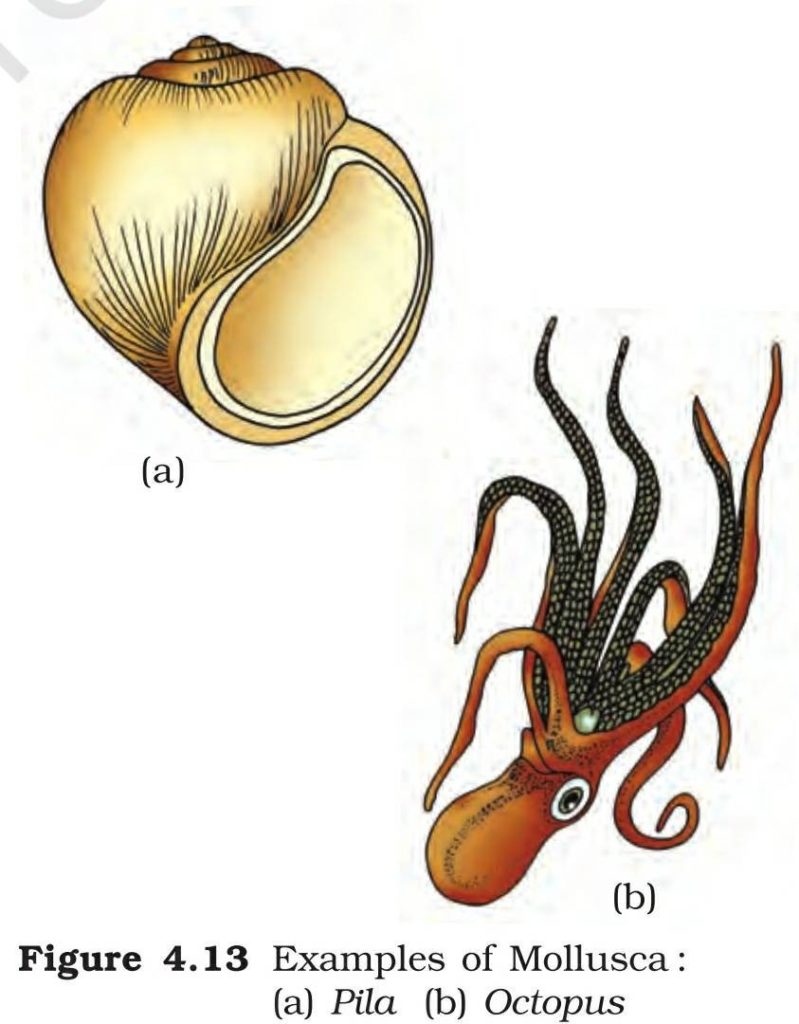
Second largest animal phylum.
- Terrestrial or aquatic (marine or fresh water)
- Organ-system level of organisation, bilaterally symmetrical, triploblastic and coelomate.
- Body is covered by a calcareous shell and is unsegmented with a distinct head, muscular foot and visceral hump. (NEET 2019)
- A soft and spongy layer of skin forms a mantle over the visceral hump.
- The space between the hump and the mantle is called the mantle cavity in which feather like gills are present. They have respiratory and excretory functions.
- The anterior head region has sensory tentacles.
- The mouth contains a file-like rasping organ for feeding, called radula. (NEET 2019)
- Usually dioecious and oviparous with indirect development.
Examples: Pila (Apple snail), (NEET 2012,2019) Pinctada (Pearl oyster), Sepia (Cuttlefish), Loligo (Squid), Octopus (Devil fish), Aplysia (Seahare), Dentalium (Tusk shell) and Chaetopleura (Chiton).
Phylum - Echinodermata
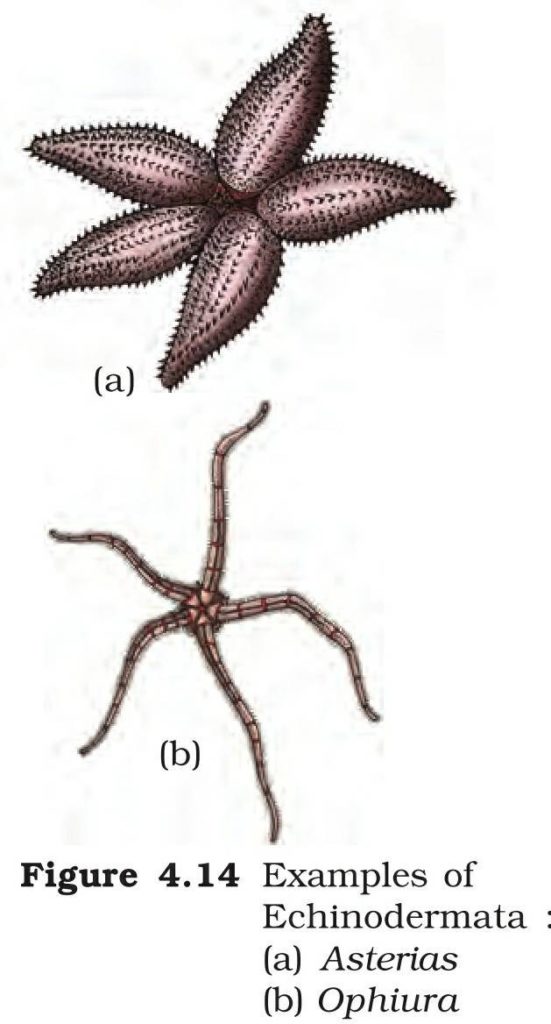
- Endoskeleton of calcareous ossicles and, hence, the name Echinodermata (Spiny bodied)
- All are marine with organ-system level of organisation. (NEET 2014)
- Adult echinoderms are radially symmetrical but larvae are bilaterally symmetrical.
- Triploblastic and coelomate animals.
- Digestive system is complete with mouth on the lower (ventral) side and anus on the upper (dorsal) side.
- Most distinctive feature of echinoderms is the presence of water vascular system which helps in locomotion, capture and transport of food and respiration.
- An excretory system is absent.
- Sexes are separate.
- Reproduction is sexual.
- Fertilisation is usually external development is indirect with free-swimming larva.
Examples: Asterias (Star fish) (NEET 2012), Echinus (Sea urchin), Antedon (Sea lily), Cucumaria (Sea cucumber) and Ophiura (Brittle star).
Phylum - Hemichordata
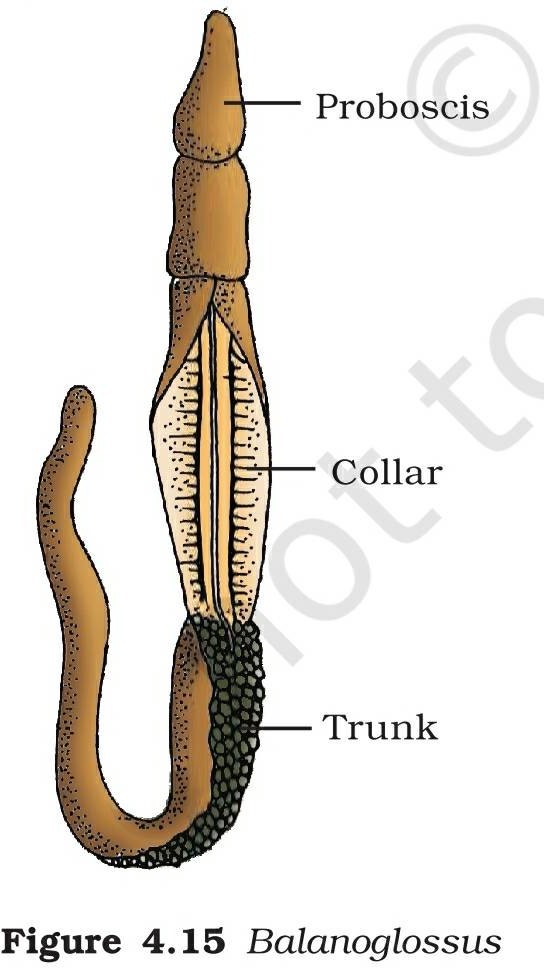
- Earlier considered as a sub-phylum under phylum Chordata.
- A rudimentary structure in the collar region called stomochord, a structure similar to notochord.
- Small group of worm-like marine animals with organ-system level of organisation, bilaterally symmetrical, triploblastic and coelomate animals.
- Body is cylindrical and is composed of an anterior proboscis, a collar and a long trunk.
- Pharynx with gill slits are present as same as chordata. (NEET 2017) Circulatory system is of open type.
- Respiration takes place through gills.
- Excretory organ is proboscis gland.
- Sexes are separate, Fertilisation is external and development is indirect. Examples: Balanoglossus and Saccoglossus.
Phylum - Chordata
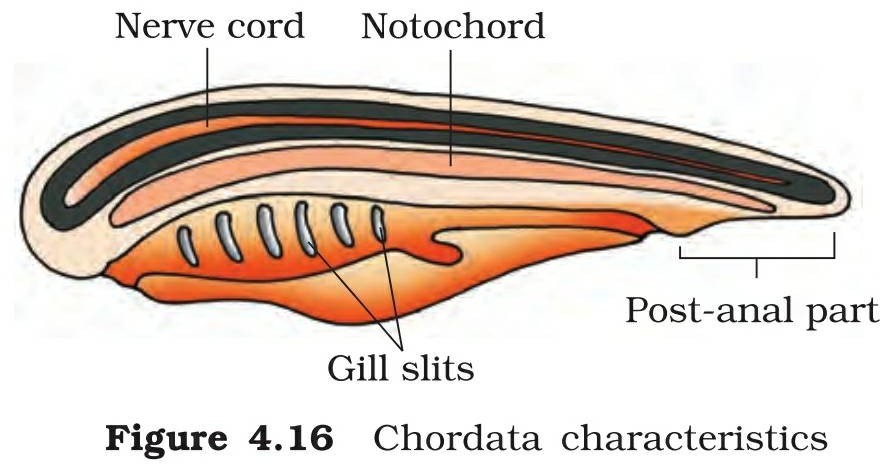
- Fundamental Character
Presence of a notochord, a dorsal hollow nerve cord and paired pharyngeal gill slits.
Bilaterally symmetrical, triploblastic, coelomate with organ-system level of organisation.
- Possess a post anal tail and a closed circulatory system.
- Difference between Chordata and non-chordata in Table 4.1
- Divided into three subphyla:
- Urochordata or Tunicata
- Cephalochordata
- Difference between chordate and non chordate

Vertebrata.
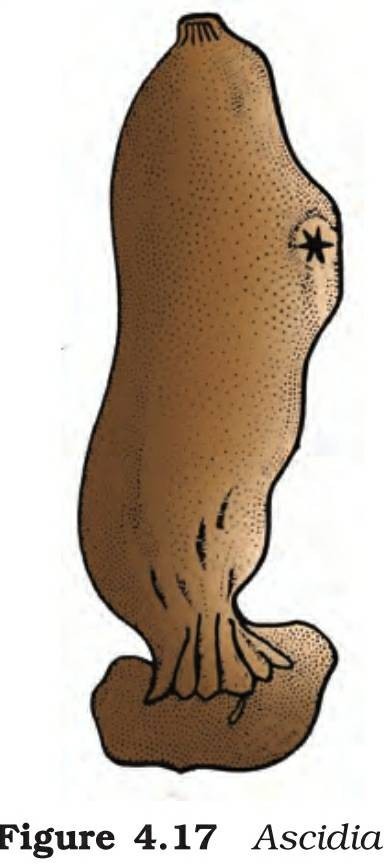
- Subphyla Urochordata and Cephalochordata are often referred to as protochordates are exclusively marine. (NEET 2014)
- In Urochordata, notochord is present only in larval tail.
- In Cephalochordata, notochord extends from head to tail region and is persistent throughout their life.
Examples: Urochordata – Ascidia, Salpa, Doliolum;
Cephalochordata – Branchiostoma (Amphioxus or Lancelet).
- Vertebrata possess notochord during the embryonic period.
- Notochord is replaced by a cartilaginous or bony vertebral column in the adult.
All vertebrates are chordates but all chordates are not vertebrates.
Vertebrates have a ventral muscular heart with two, three or four chambers, kidneys for excretion and osmoregulation and paired appendages which may be fins or limbs.
Vertebrata divided as shown in Diagram-
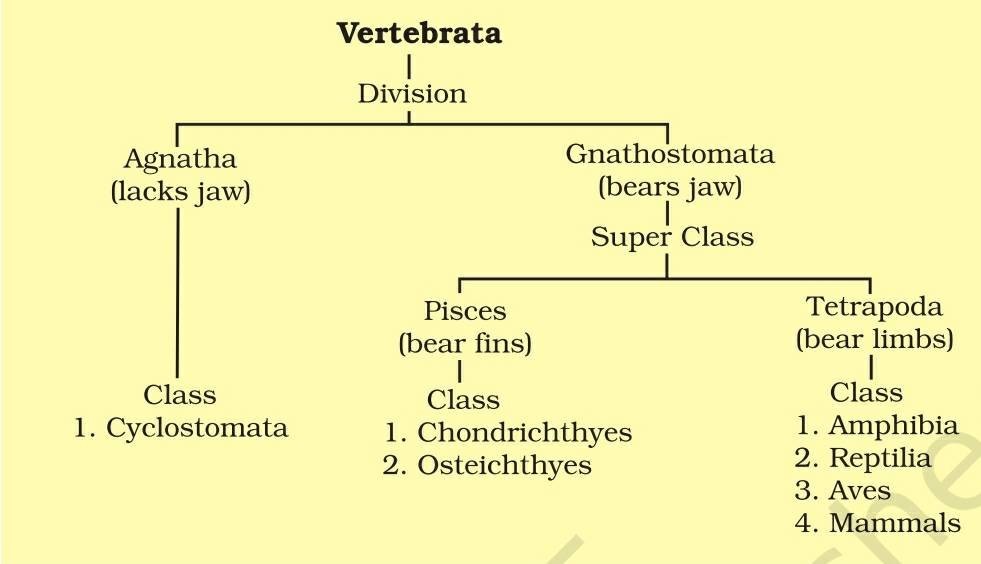
Division- Agantha
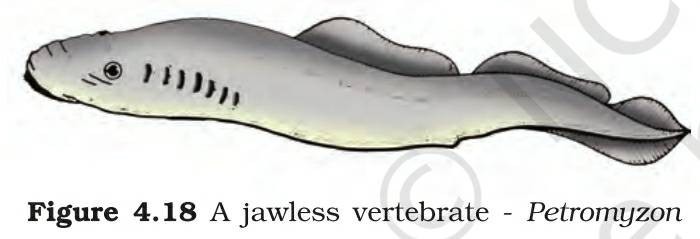
Class - Cyclostomata
- All living members of the class Cyclostomata are ectoparasites on some fishes.
- An elongated body bearing 6-15 pairs of gill slits for respiration.
- A sucking and circular mouth without jaws. (NEET 2011,2015,2016)
- Body is devoid of scales and paired fins.
- Cranium and vertebral column are cartilaginous.
- Circulation is of closed type.
- Cyclostomes are marine but migrate for spawning to fresh water. After spawning, within a few days, they die. Their larvae, after metamorphosis, return to the ocean. (NEET 2015)
Examples: Petromyzon (Lamprey) and Myxine (Hagfish). (NEET 2013)
Super Class- Pisces (two class)
(i) Chondrichthyes (ii) Oesteichthyes
(I) Class – Chondrichthyes
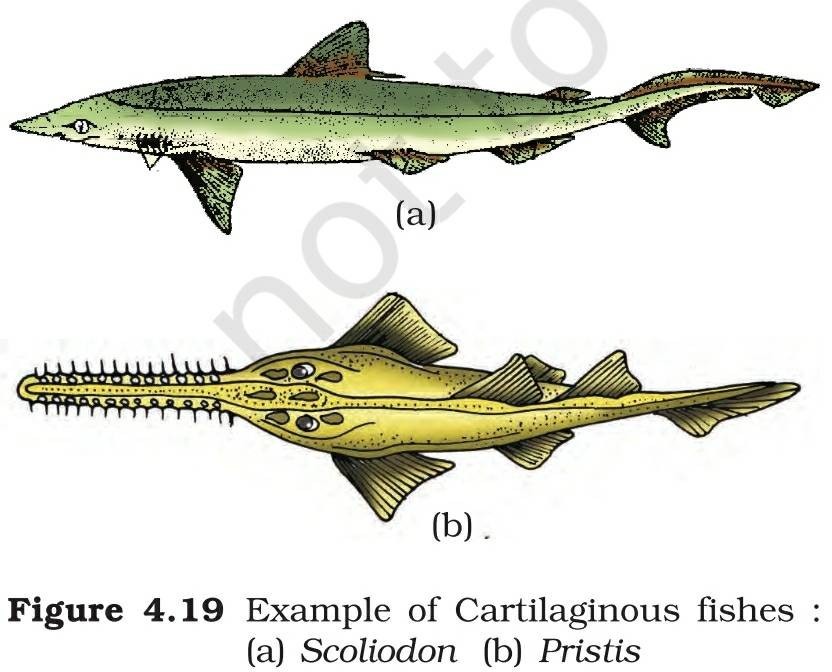
- Marine animals with streamlined body and have cartilaginous endoskeleton. (NEET 2011,2016)
- Mouth is located ventrally.
- Notochord is persistent throughout life.
- Gill slits are separate and without operculum (gill cover). (NEET 2016)
- The skin is tough, containing minute placoid scales.
- Teeth are modified placoid scales which are backwardly directed.
- Their jaws are very powerful.
- These animals are predaceous.
- Due to the absence of air bladder, they have to swim constantly to avoid sinking.
- Heart is two-chambered (one auricle and one ventricle).
- Some have electric organs (e.g., Torpedo) and some possess poison sting (e.g., Trygon). (NEET 2014)
- They are cold-blooded (poikilothermous) i.e., they lack the capacity to regulate their body temperature.
- Sexes are separate. In males pelvic fins bear claspers.
- Internal fertilisation and many of them are viviparous.
- Examples: Scoliodon (Dog fish), Pristis (Saw fish), Carcharodon (Great white shark), Trygon (Sting ray) (NEET 2013,2017)
Class – Osteichthyes
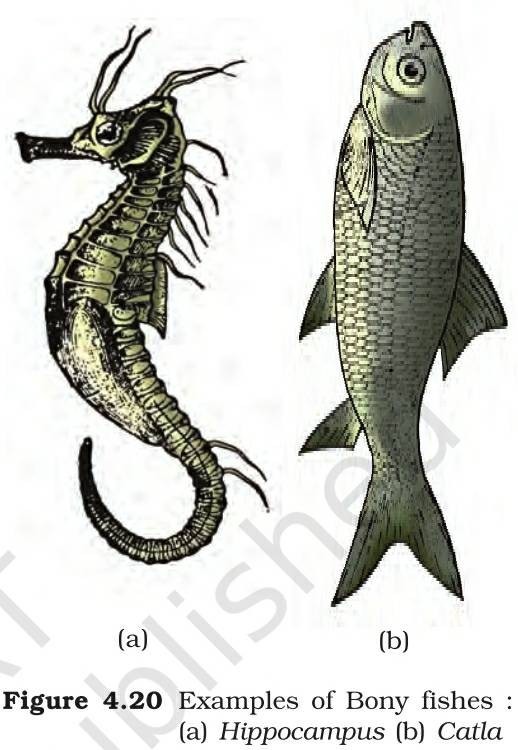
- Includes both marine and fresh water fishes with bony endoskeleton.
- Body is streamlined.
- Mouth is mostly terminal
- Four pairs of gills which are covered by an operculum on each side.
- Skin is covered with cycloid/ctenoid scales.
Air bladder is present which regulates buoyancy.
- Heart is two chambered (one auricle and one ventricle) and cold- blooded animals.
- Sexes are separate and Fertilisation is usually external.
- Mostly oviparous and development is direct.
Examples: Marine – Exocoetus (Flying fish), Hippocampus (Sea horse);
Freshwater – Labeo (Rohu), Catla (Katla), Clarias (Magur); Aquarium – Betta (Fighting fish), Pterophyllum (Angel fish).
Super Class - Tetrapoda ( 4 class)
1. Amphibia 2. Reptilia 3. Aves 4. Mammals
Amphibia
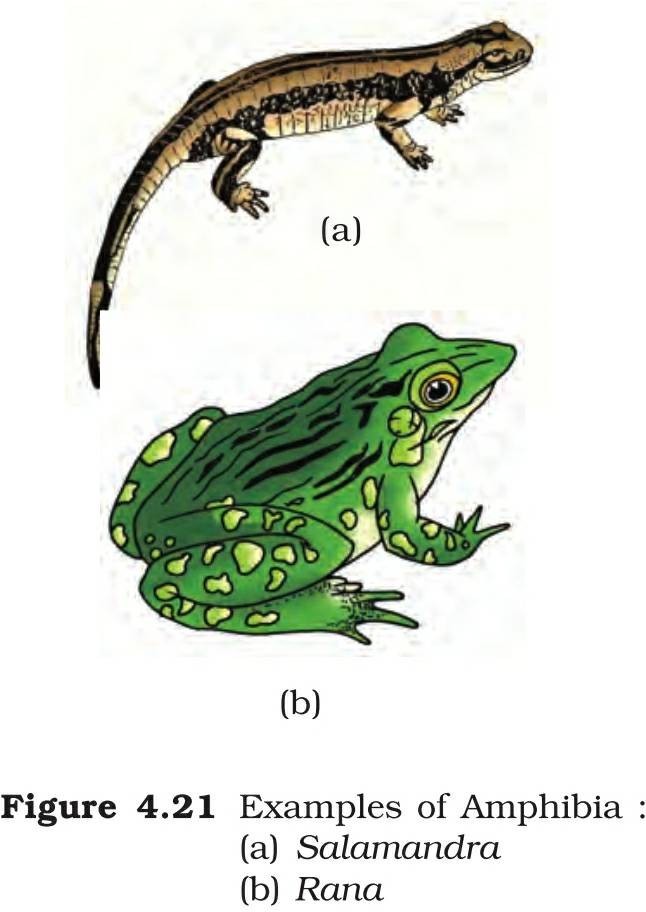
- Name indicates (Gr., Amphi : dual, bios, life), amphibians can live in aquatic as well as terrestrial habitats.
- Most of them have two pairs of limbs.
- Body is divisible into head and trunk.
- Tail may be present in some.
- Skin is moist (without scales), eyes have eyelids.
- A tympanum represents the ear. (NEET 2011)
- Alimentary canal, urinary and reproductive tracts open into a common chamber called cloaca which opens to the exterior.Respiration is by gills, lungs and through skin.
- Heart is three chambered (two auricles and one ventricle) and cold-blooded animals.
- Sexes are separate, Fertilisation is external and oviparous with development is indirect.
- Examples: Bufo (Toad), Rana (Frog), Hyla (Tree frog), Salamandra (Salamander), Ichthyophis (Limbless amphibia). (NEET 2011,2013)
Reptilia
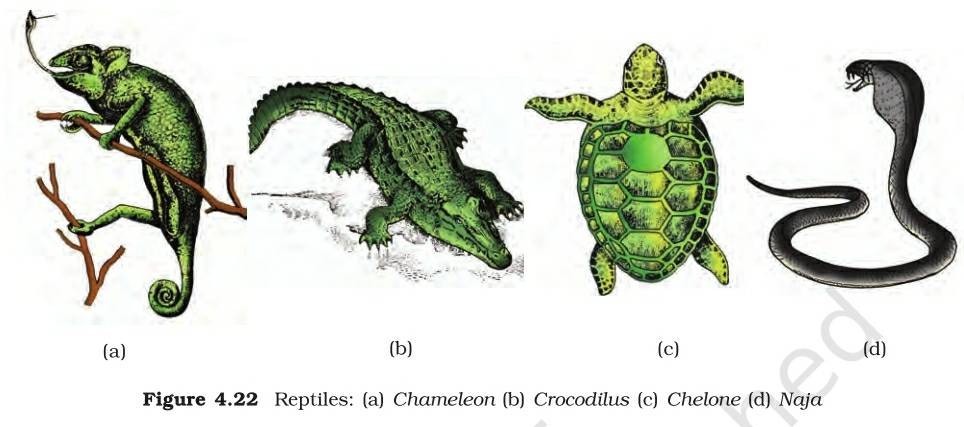
- Name refers their creeping or crawling mode of locomotion (Latin, repere or reptum, to creep or crawl).
- Mostly terrestrial animals and their body is covered by dry and cornified skin, epidermal scales or scutes.
- Do not have external ear openings Tympanum represents ear.
- Limbs, when present, are two pairs.
- Heart is usually three-chambered, but four- chambered in crocodiles. (NEET 2011,2016)
- Reptiles are poikilotherms( cold - blooded) (NEET 2018)
- Snakes and lizards shed their scales as skin cast.
- Sexes are separate, Fertilisation is internal are oviparous and development is direct.
Examples: Chelone (Turtle), Testudo (Tortoise), Chameleon (Tree lizard), Calotes (Garden lizard), Crocodilus (Crocodile), Alligator (Alligator). Hemidactylus (Wall lizard),
Poisonous snakes – Naja (Cobra), Bangarus (Krait), Vipera (Viper).
Aves
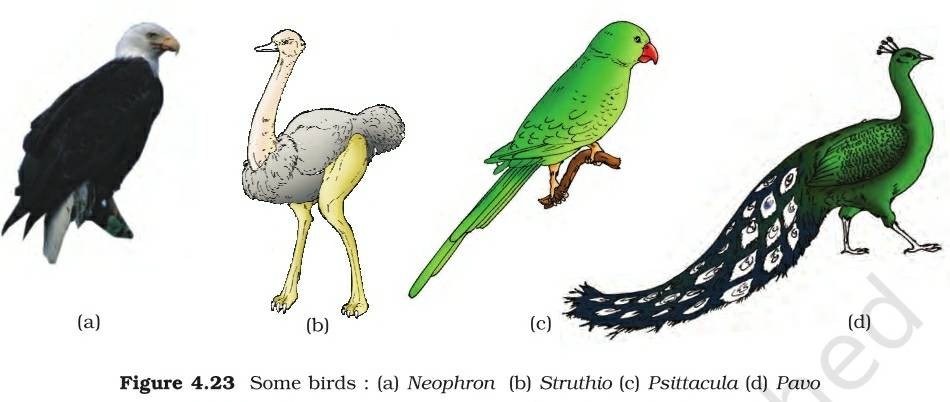
- Characteristic feature presence of feathers and most of them can fly except flightless birds (e.g., Ostrich).
- Possess beak and forelimbs are modified into wings.
- Hind limbs generally have scales and are modified for walking, swimming or clasping the tree branches.
- Skin is dry without glands except the oil gland at the base of the tail. (NEET 2015)
- Endoskeleton is fully ossified (bony) and the long bones are hollow with air cavities (pneumatic).
- Digestive tract of birds has additional chambers, the crop and gizzard. (NEET 2018)
- Heart is completely four chambered and warm- blooded (homoiothermous) animals, i.e., they are able to maintain a constant body temperature.
- Respiration is by lungs.
- Air sacs connected to lungs supplement respiration.
- Sexes are separate, Fertilisation is internal are oviparous and development is direct.
Examples : Corvus (Crow), Columba (Pigeon), Psittacula (Parrot), Struthio (Ostrich), Pavo(Peacock), Aptenodytes (Penguin), Neophron (Vulture).
Mammalia
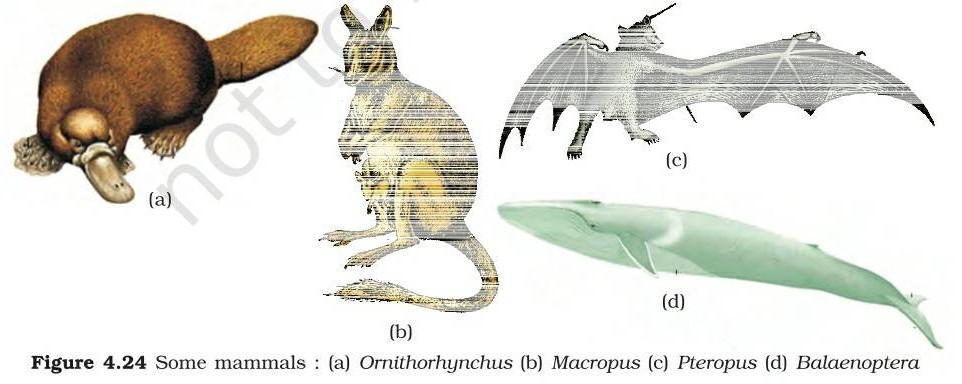
- Found in a variety of habitats – polar ice caps, deserts, mountains, forests, grasslands and dark caves.
- Some adapted to fly or live in water.
- Most unique mammalian characteristic
- presence of milk producing glands (mammary glands) for young ones nourished.
- two pairs of limbs, adapted for walking, running, climbing, burrowing, swimming or flying.
- unique in possessing hair. (NEET 2011,2015)
- External ears or pinnae are present.
- Different types of teeth are present in the jaw.
- Heart is four chambered and homoiothermous.
- Respiration is by lungs.
- Sexes are separate and fertilisation is internal.
- Viviparous with few exceptions and development is direct.
- Examples: Oviparous-Ornithorhynchus (Platypus); (NEET 2011,2015,2016)
Viviparous Macropus (Kangaroo), Pteropus (Flying fox), Camelus (Camel), Macaca (Monkey), Rattus (Rat), Canis (Dog), Felis (Cat), Elephas (Elephant), Equus (Horse), Panthera tigris (Tiger), Panthera leo (Lion).
Aquatic- Delphinus (Common dolphin), Balaenoptera (Blue whale), (NEET 2017)

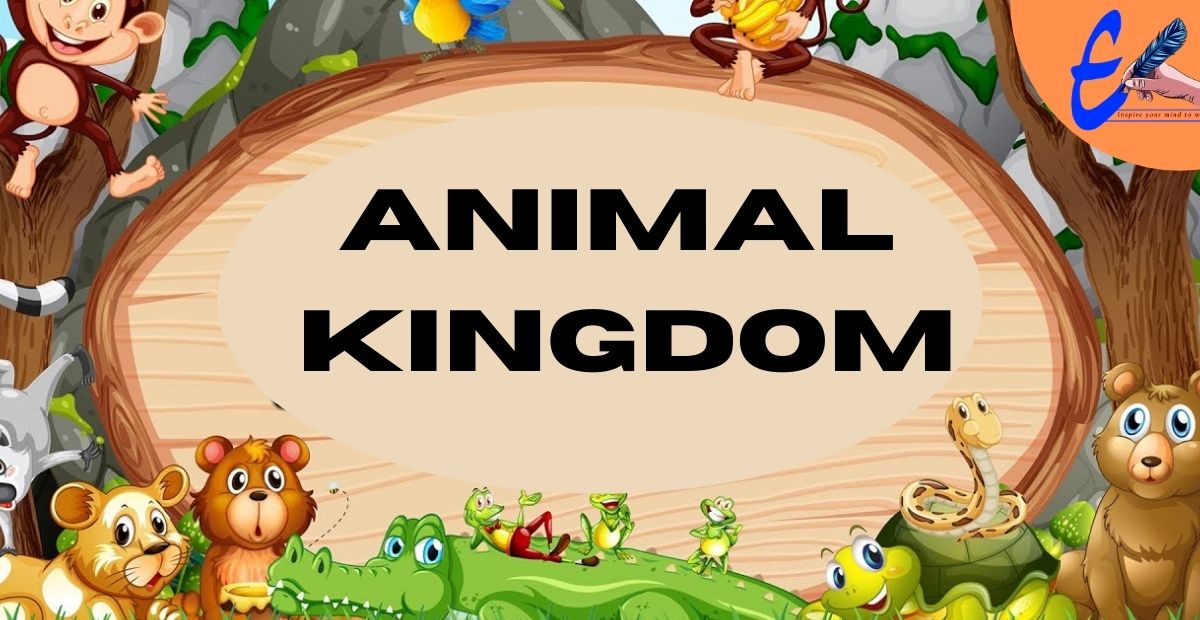
This content is very helpful for NEET
aspirants.. I’m so grateful to Eklavya classes for the contents , guidance and inspiration which helps me a lot in the journey to achieve my goals ☺️..
… [Trackback]
[…] Find More on on that Topic: eklabhyaclasses.com/blog/animal-kingdom/ […]
… [Trackback]
[…] Info on that Topic: eklabhyaclasses.com/blog/animal-kingdom/ […]
… [Trackback]
[…] Information to that Topic: eklabhyaclasses.com/blog/animal-kingdom/ […]
… [Trackback]
[…] Find More here on that Topic: eklabhyaclasses.com/blog/animal-kingdom/ […]